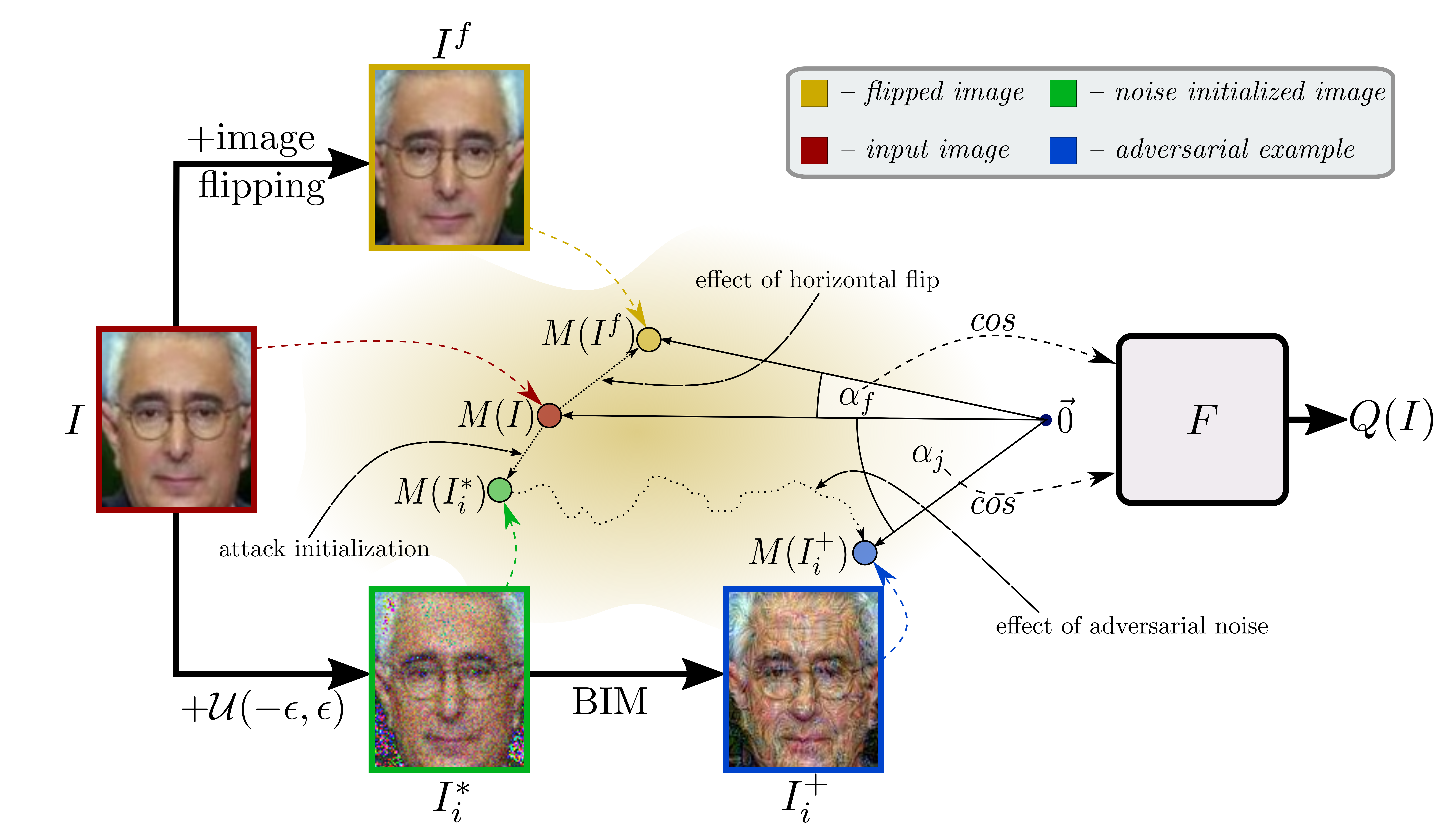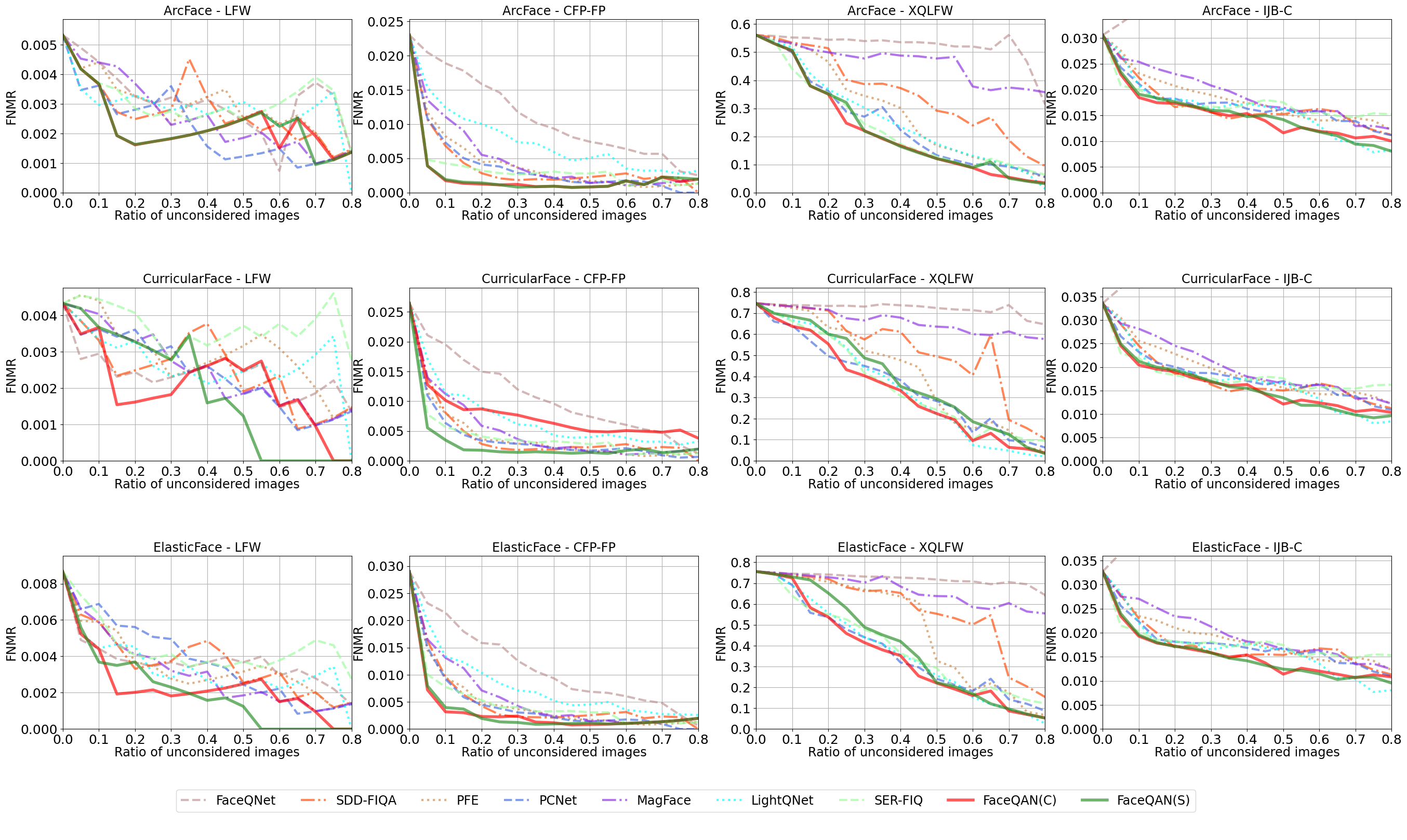This is the official repository of the FaceQAN: Face Image Quality Assessment Through Adversarial Noise Exploration paper in proceedings of the ICPR 22 conference.
Recent state-of-the-art face recognition (FR) approaches have achieved impressive performance, yet unconstrained face recognition still represents an open problem. Face image quality assessment (FIQA) approaches aim to estimate the quality of the input samples that can help provide information on the confidence of the recognition decision and eventually lead to improved results in challenging scenarios. While much progress has been made in face image quality assessment in recent years, computing reliable quality scores for diverse facial images and FR models remains challenging. In this paper, we propose a novel approach to face image quality assessment, called FaceQAN, that is based on adversarial examples and relies on the analysis of adversarial noise which can be calculated with any FR model learned by using some form of gradient descent. As such, the proposed approach is the first to link image quality to adversarial attacks. Comprehensive (cross-model as well as model-specific) experiments are conducted with four benchmark datasets, i.e., LFW, CFP–FP, XQLFW and IJB–C, four FR models, i.e., CosFace, ArcFace, CurricularFace and ElasticFace and in comparison to seven state-of-the-art FIQA methods to demonstrate the performance of FaceQAN. Experimental results show that FaceQAN achieves competitive results, while exhibiting several desirable characteristics.
Visualization of adversarial noise as a function of image quality. A clear difference can be observed in the characteristics of the adversarial noise between images of different quality. Higher quality images produce noise masks with a more distinct face-like pattern, while the lower quality masks are closer to random noise. FaceQAN takes advantage of the presented observations to estimate the quality of the input images.
High-level overview of FaceQAN. FaceQAN estimates the quality of an input sample I by exploring the characteristics of adversarial examples I+ in the embedding space of the targeted FR model M. The final quality is estimated through an aggregation function
ERC results at FMR=0.001. FaceQAN is evaluated using three state-of-the-art FR models over four datasets and in comparison to seven state-of-the-art baselines and yields highly competitive results. All results correspond to cross-model (C) quality assessment experiments. For reference purposes, model-specific FaceQAN results, marked (S), are also reported.
FaceQAN is heavily reliant on HOW THE IMAGES ARE CROPPED AND ALIGNED. The images need to be cropped as specified by the FR model used for adversarial example generation.
This is a step-by-step guide showing you how to run FaceQAN quality score inference on one or more images.
-
Clone the FaceQAN repository.
-
Obtain the CosFace - pretrained model:
-
Download the CosFace-ResNet100 model pretrained on the Glint360k dataset, available from the official InsightFace project GitHub repository.
-
Rename the file to "weights.pth" and place it within the ./models folder.
-
Using a custom model:
- To use a custom model you have to change the __calculate_score_batch()__ function located within calculate_qs.py
- Replace the line
model : torch.nn.Module = load_cosface().eval().cuda()with your custom model loader - DO NOT FORGET to also change the mean, deviation and transforms
-
-
Setup enviroment:
-
We suggest using conda to setup the appropriate environment.
-
Create and activate a new conda environment
-
Install PyTorch using
conda install pytorch torchvision torchaudio cudatoolkit=XX.X -c pytorch
Replace XX.X with the appropriate CUDA version for your graphics card.
-
-
-
Run
CUDA_VISIBLE_DEVICES=0 python calculate_qs.py -i "imagePath1" "imagePath2" ... "imagePathN" -sp "saveLocation", where imagePathX refers to the disk location of the X-th image to be processed, and saveLocation refers to the disk location where the results will be stored.-
The results are stored in a pickle format, which contains a dictionary of <imagePathX>:<qualityScoreX>(key:value) items.
-
Other hyper-parameters can be changed using the switches listed below:
- -e <float> : "changes the value of ε"
- -l <int> : "controls the number of iterations"
- -k <int> : "changes the batch size"
- -k <int> : "controls the exponent"
-
-
Perform steps 1., 2. and 3. from Quality Score Inference.
-
Download the XQLFW original dataset, available from the official XQLFW website.
-
Extract and copy the "lfw_original_imgs_min_qual0.85variant11" image folder into ./dataset.
-
Crop and align all images as specified by the FR model used for adversarial attacks.
We suggest using either RetinaFace or MTCNN for face detection. -
Run
CUDA_VISIBLE_DEVICES=0 python evaluation/xqlfw_eval.py -
The script will create a new pickle file with the quality scores of all XQLFW images in ./evaluation
NOTE. Results may vary slightly between rounds due to the innate randomness of adversarial example generation.
If you use any of the code provided in this repository, please cite the following paper:
@inproceedings{babnikICPR2022,
title={{FaceQAN: Face Image Quality Assessment Through Adversarial Noise Exploration}},
author={Babnik, {\v{Z}}iga and Peer, Peter and {\v{S}}truc, Vitomir},
booktitle={Proceedings of the IAPR International Conference on Pattern Recognition (ICPR)},
year={2022},
}


